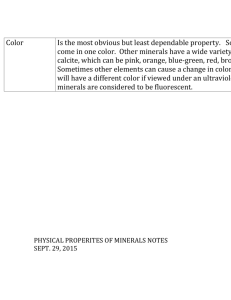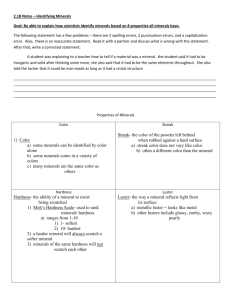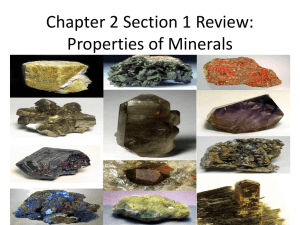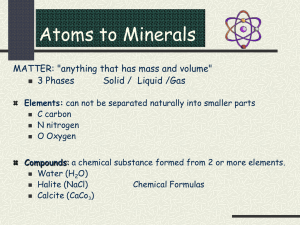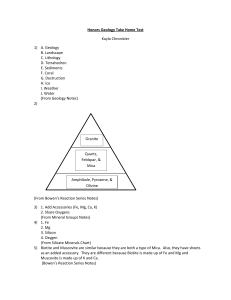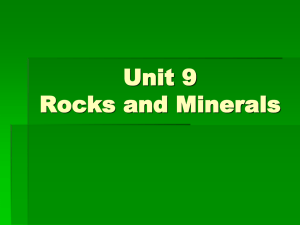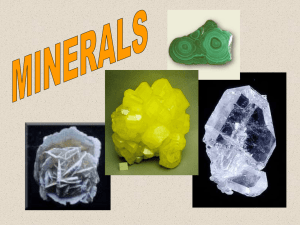Identifying Minerals
advertisement
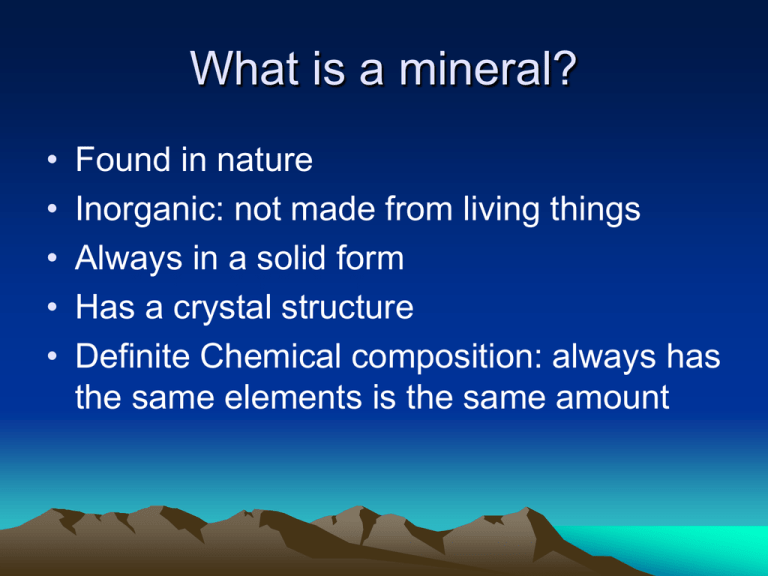
What is a mineral? • • • • • Found in nature Inorganic: not made from living things Always in a solid form Has a crystal structure Definite Chemical composition: always has the same elements is the same amount Formation of Minerals • Many minerals come from magma •When magma cools mineral crystals are formed. • Magma that cools fast has small crystals • Magma that cools slow has large crystals •The two most abundant elements in the earths crust are oxygen and silicon. Minerals • Each mineral has its own specific properties that can be used to identify it. • Learning these properties will make it easy to identify minerals. Hardness • One of the best clues to use is hardness. • Hardness is a mineral’s resistance to being scratched. • Mohs hardness scale – invented by Friedrich Mohs in 1812 • Ranks 10 minerals from softest to hardest Mohs hardness scale • • • 1 -Talc – softest known mineral. It flakes easily when scratched by fingernail. 2 – Gypsum – a fingernail can easily scratch it. 3 – Calcite – A fingernail cannot scratch it, but a copper penny can. Mohs continued • 4 – Fluorite – A steel knife can easily scratch it. • 5 –Apatite – A steel knife can scratch it. • 6 – Feldspar – Cannot be scratched by a steel knife, but it can scratch window glass. • 7 – Quartz – Can scratch steel and hard glass easily. Mohs continued • 8 – Topaz – Can scratch quartz. • 9 – Corundum – Can scratch topaz. • 10 – Diamond – Hardest known mineral. Diamond can scratch all other substances. Color • Color is easy to identify • Color can be used only to identify a few minerals that always have their own characteristic color. • Azurite – always blue • Malachite – always green Streak • The streak of a mineral is the color of its powder. • You rub the mineral against a streak plate to see the powder. • Pyrite – gold in color – black streak • Gold – gold in color – golden yellow streak Luster • Luster is how the mineral reflects light • Minerals with metals in them are often shiny. • Quartz is glassy. • Other terms to describe luster are metallic, waxy, pearly, earthy, and vitreous, Density • Each mineral has a characteristic density • Density = the measure of how much matter is in a given amount of space. • No matter what size of the sample, the density will always be the same. • To find the density, measure the mass with a balance and then put the sample in water to find the volume. Use the formula D = Mass/Volume (g/cm³) to calculate. Cleavage • Cleavage is the tendency of some minerals to break along smooth, flat surfaces. • How the atoms in the crystal are arranged will determine if the mineral has cleavage. • Mica breaks easily into distinct sheets. Fracture • Most minerals do not split apart evenly. • Fracture is the tendency of some minerals to break unevenly along curved or irregular surfaces. • Quartz – shell-like shaped fracture, looks like chipped glass • Pure metals – form jagged points Special properties • Fluorite and Calcite are minerals that glow under ultraviolet light • Magnetite is a natural magnet that attracts iron. • Calcite will bubble or “fizz” when acid is placed on it. • Halite taste salty • Minerals that contain radium and uranium are radioactive. Mining Minerals An ore is a mineral deposit large enough and pure enough to be mined for profit. Mining 1. Strip mining – earthmoving equipment scrapes away soil to expose ore 2. Open-pit – miners use giant earthmoving equipment to dig a tremendous pit 3. Shaft mining – network of tunnels that extend deep into the ground. Reclamation Mining can be harmful to the environment. Reclamation – process by which land used for mining is returned to its original state or better. Another way to reduce the effects of mining is to reduce our need for minerals - recycling Essential Questions Please answer in complete sentences • What properties can you use to determine the type of mineral? • Describe how you can test a mineral to determine its hardness, density, and streak. • How are cleavage and fracture similar? How are they different? • Explain why you can’t rely on any single test or property when you are trying to identify a mineral.

